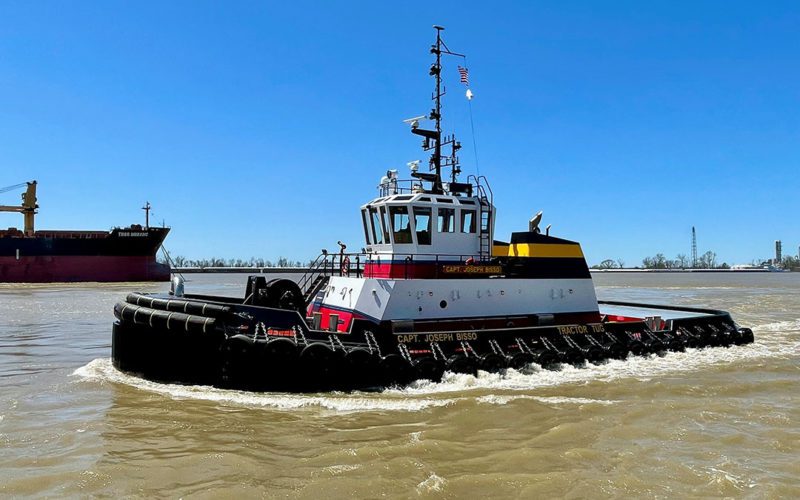
The Zen-Noh Grain Corp. (ZGC) export elevator near Convent, La., is one of the busiest on the Lower Mississippi River. It runs around the clock loading American grain into ships heading overseas.
Bisso Towboat Co. of Luling, La., and its three azimuthing stern drive (ASD) tugboats positioned just upriver, play a key role in keeping the terminal running efficiently. Day in, day out, its crews dock, shift and undock loaded vessels.
“They don’t like any downtime,” Capt. Ruben Dupre III, Bisso’s vice president of safety, said of the terminal operator. “As soon as one (ship) leaves, they want another one coming in.”
On a sunny spring morning, Capt. Sean Fortier left the Bisso Towboat dock at mile 165 with the company’s newest tug, the 6,008-hp Capt. Joseph Bisso. He steered downriver toward the terminal towering over the horizon. River conditions were high but not abnormal for late March.
Up ahead, the 653-foot Panama-flagged bulker Omishima Island sat low in the water, weighed down by ton upon ton of Midwestern grain. Two other Bisso Towboat tugs, Cecilia B. Slatten and Alma S., were already in position roughly side by side on the port quarter.
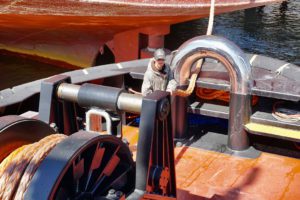
Fortier steered Capt. Joseph Bisso to the port bow, its own bow facing the ship, while engineer Blaine McNabb got a line up. The undocking maneuver was simple and straightforward, and one the tug crews knew well. First, they’d pull the ship off the dock, then Fortier would stretch the line and begin backing hard to spin the bow 180 degrees.
The maneuver began under the guidance of a New Orleans-Baton Rouge Steamship Pilots Association (NOBRA) pilot who gave commands to the three tugs. The 5-mph current helped push Omishima Island’s bow downriver while the aft tugs helped the stern along.
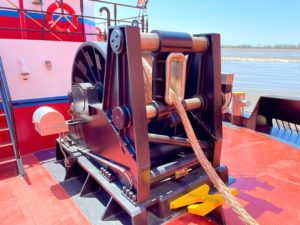
After hauling in their lines, the three tugs chugged back toward the hulking ZGC terminal. Another ship, the Singapore-flagged Nord Sound, was tied to the dock about 1,000 feet upriver. With Omishima Island now underway, Nord Sound would take its place loading cargo.
The Zen-Noh Grain Corp. was established in 1979. The facility handles corn, soybeans, sorghum and other grains. It has a state-of-the-art export elevator that can load and unload 150,000 bushels per hour, according to the company’s website. Much of that grain is exported to Zen-Noh feed mills in Japan.
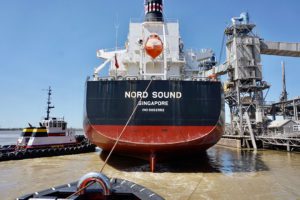
ZGC has a global footprint with operations in Canada, Brazil, Hong Kong and the Pacific Northwest. Its export elevator at the Convent, La., terminal is one of the fastest in the world. Its affiliate company, Consolidated Grain and Barge, facilitates barge shipments from Midwestern farms to the Convent terminal for export.
Capt. Joseph Bisso is the ninth tugboat in a series designed more than two decades ago by Castleman Maritime (and a Top Tug in the 2022 issue of American Tugboat Review). Like its predecessors, it was built at Main Iron Works in Houma, La.
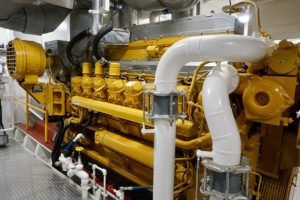
The 100-footer is the second Bisso tug with Tier 4 Caterpillar 3516 engines and the first with Schottel z-drives. It is also the first with Cat C4.4 generators and Schuyler Cos. cylindrical bow fenders.
Capt. Joseph Bisso operates with a four-person crew that works a seven-on, seven-off rotation. Fortier and McNabb were joined by mate Allen Cobb and deck hand William Healy. The tug has four cabins, all of which are below the waterline.
Bisso operates the most ASD tugboats on the Lower Mississippi, which company President Scott Slatten believes to be a competitive advantage. He considers the vessels safer and more versatile than many of the other ship-assist tugboats working this part of the river.
“This is power on the river, as well as maneuverability,” said Fortier, who joined the company more than 20 years ago.
“We can give the pilot what they need almost instantly, in any direction,” he added.
Shifting ships downriver into position to load cargo is another job Bisso Towboat crews know well. But one quirk at the Zen-Noh dock is an eddy that can make ships behave strangely as they come off the dock.
“It’s very unpredictable which way the ship might go,” Fortier said of the eddy.
“That’s why it’s so important that we use these ASD tugboats, which are among the safest and most responsive anywhere. It makes the pilot’s job that much easier,” Dupre added.
Capt. Joseph Bisso’s wheelhouse is equipped with Simrad navigation electronics. Three displays hang from the ceiling showing radar, navigation charts and AIS, and visuals from a FLIR camera. Displays mounted into the wooden panels between forward windows show the vessel’s speed, engine rpms, z-drive orientation and other data.
Alma S. took position at Nord Sound’s port quarter while Cecilia B. Slatten was roughly amidships on the port side. Capt. Joseph Bisso took position centerline aft. The tugs worked together to pull the ship about 75 yards off the terminal.
Shifting the vessel in the current required patience, finesse and excellent communication between the pilot and all three tugs. Capt. Joseph Bisso effectively functioned as a brake for the ship, which used its engine coming ahead to counter the current pushing it downriver.
“If the ship doesn’t have enough power, that is what we are here for,” Fortier said. “And we can also help move the ship to port or to starboard, whatever they need.”
Like the last several Bisso tugboats in the series, Capt. Joseph Bisso is equipped with a JonRie InterTech Series 240 escort winch on the bow. Its foot-pedal controls let the operator keep their hands on the sticks during critical maneuvers. The winch is wrapped with 500 feet of 3-inch Samson Saturn-12 line that runs through a stainless-steel bow staple.
That shiny staple is standard across the Bisso Towboat fleet, and something its crews strive to keep looking good. On this morning, it glistened in the South Louisiana sun.
As the ship approached the loading position at the terminal, the NOBRA pilot worked the rudder and the tugs to steer the ship exactly where she wanted it. She routinely stepped onto the bridge wings to verify distances as the ship inched toward the dock.
Once she had it lined up, the two Bisso tugs on the port side nudged the ship into position. Line handlers secured it to the dock to prepare for loading, which can last 24 hours or longer.
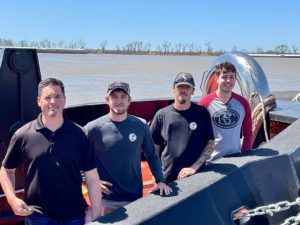
The Bisso crews had some downtime before the next movement at ZGC. The sequence usually consists of getting one vessel off the dock, shifting another into position to load grain, and then docking another vessel into the berth Nord Sound recently occupied.
Water sprayed over the bow as Fortier pushed Capt. Joseph Bisso upriver at about 10 knots. The tug passed two ships positioned in the Burnside Anchorage as it turned into the company dock. The respite would prove short-lived as another ship was already underway to take its position at ZGC’s vacant berth. •

